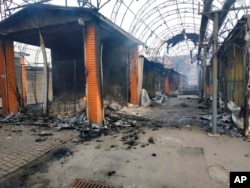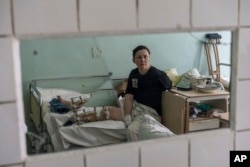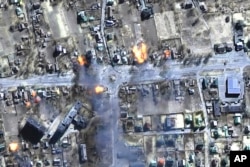His body pressed flat to the ground, Andriy Tsaplienko covered his head with his hands as wave after wave of shells exploded around him.
An experienced war correspondent, he hadn't been too worried about an assignment covering the evacuation of civilians from Chernihiv. Now he was in the middle of a Russian bombardment.
As the shells fell, he felt a jolt to his leg. He had been hit.
Tsaplienko had been following a tip that day. It was March 25 and local authorities in Chernihiv alerted him to an evacuation in the northern Ukrainian city.
The 53-year-old, his cameraman and a driver from the 1+1 news channel immediately left Kyiv and headed for the city.
But shortly after they reached Anysiv, a village on the southern outskirts of Chernihiv, a Russian bombardment started, wounding the journalist and many civilians.
"When we came to Anysiv … we saw smoke rising on the other bank of the river," Tsaplienko told VOA during a call from his hospital bed in Kyiv. "There were three columns of smoke after shelling and we also heard another shelling in the distance, maybe five kilometers away."
Still, Tsaplienko says, he "determined in this instance there were no danger for us." The shelling seemed far enough away to not be a risk.
The situation quickly changed and within about 10 minutes Tsaplienko was struck by shrapnel as he ducked for cover.
"At first glance, the wound didn't look serious, but after we came to the hospital, they told me there were two wounds in my upper thigh," Tsaplienko told VOA.
He escaped lightly. While nobody was reported killed, several civilians were wounded, according to a local military official.
And despite Moscow's pledge to scale down military operations, Chernihiv's governor, Viacheslav Chaus, said Wednesday there has been no pause in Russian attacks.
Tsaplienko hadn't expected the area he was in to be targeted. The village didn't appear to have any military target, he added. Just civilians.
"Chernihiv is surrounded by Russian forces from three sides," Tsaplienko said. "There is only one passage into Chernihiv through the village of Anysiv."
The Russians destroyed the main bridge over the Desna River, leaving a small pedestrian bridge from Anysiv as the main route out for those fleeing.
"Now there is no safe place in Ukraine," he said. "Any point of Ukrainian territory is a potential site for attacks by Russia, whether by artillery or rockets."
Before the war, the city population was nearly 285,000. Local officials, however, say that number has halved since February 24.
Ukrainian officials, Western governments and international human rights bodies accuse Russia of targeting civilian infrastructure in Chernihiv and elsewhere in Ukraine. Hospitals and places where residents were sheltering were bombed.
Russia denies targeting civilians and says the evidence collected by media and other independent bodies is "fake news."
Second attack
Tsaplienko has covered hostilities in Ukraine since 2014. That year, while covering Crimea for the Inter news channel, Russian forces detained him along with two other journalists and two cameramen.
"It was such an experience," Tsaplienko said. "My crew and I were taken hostage. They kept us for several hours and beat us. They actually tortured us. They broke my ribs, and the rest of my crew was also beaten. They broke some of our equipment and took the rest."
"We were just reporting news to the mainland in Ukraine and the FSB [Russia's Federal Security Service] thought we posed a danger to them," he said.
It was with that experience in mind that Tsaplienko approached the Chernihiv assignment.
When they arrived in Anysiv, about 50 civilians were there: some leaving Chernihiv, others trying to go back to the city to retrieve relatives and belongings.
Then, Tsaplienko says, they heard a drone.
A member of the Ukrainian military approached. "He was a bit nervous. He told us, 'Look guys, there is a Russian UAV [unmanned aerial vehicle] above us! Can you hide your car as far as possible from the street? Because normally when we see a Russian drone, it means they could possibly start the shelling.'"
Tsaplienko says he figured the drone was for reconnaissance. No military targets were in the area, except for less than a dozen military personnel with small arms. The rest, he said, were civilians.
"Since we were wearing bulletproof jackets and helmets and our car had the press mark on it, I think the military guy … thought they would make us a target," Tsaplienko said. "So perhaps the Ukrainian military officer thought the press could be a target for the Russians."
At least five journalists have been killed and several wounded since the beginning of Russia's invasion of Ukraine. Others have been detained, including by Russian forces.
The U.N. and other bodies have repeatedly called on all sides in the conflict to ensure the safety of media, who are civilians, not targets.
Under fire
After moving the car, Tsaplienko and his colleagues headed to where civilians were still gathering.
Then the shelling began.
"There were explosions over us. It sounded like a huge wave," Tsaplienko said. "I fell down, and I held my helmet with both hands," he added. "I think everybody fell down at this moment."
In addition to his cameraman and driver, Tsaplienko was accompanied by a correspondent for Turkish state television TRT World, and his cameraman.
"I felt a huge hit on my thigh. Like somebody hitting you with a long metal stick," Tsaplienko recalled.
A military officer ordered them to seek shelter in the basements of nearby houses.
"We started going door to door, but the doors were locked, and [a soldier] kept yelling at us to lay our heads down and quickly look for shelter.
"Then my Turkish colleague told me, 'Andriy, you're bleeding!' I didn't feel anything … I was in shock, I don't know, perhaps it was my adrenaline," the journalist said.
The crew managed to find shelter, but the bombing lasted about 90 minutes.
"There was no break," he said. "You hear an explosion, then about 10 seconds later you hear something like this 'bam, bam, bam!'"
Tsaplienko was later transported to a hospital, so he didn't see what happened to the residents who were trying to flee.
But, he says, a doctor told him of a 46-year-old woman severely injured.
Tsaplienko has covered conflicts in more than a dozen countries, including Afghanistan, Iraq, Lebanon, Syria, South Sudan and the Democratic Republic of Congo.
But he says it's different when the conflict hits close to home.
"I haven't seen before so much sophisticated weapons used against civilians," he said.
That's why once fully recovered, "I should go back to the job and continue telling the world what's going on in this war."















